|
 |
 |
|
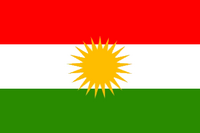 |
|
|
An ethnically Kurdish
enclave, confined within the artificial borders of four other countries
(Iraq, Iran, Turkey, and Syria), which has been trying to attain a liberated
homeland. For centuries they
have dreamed of having an independent homeland, however each time the dream
has been thwarted. An independent Kurdistan was promised after World War I,
however instead their land was divided between Turkey and Iraq. After the
First Gulf War in 1991 the Kurds in Iraq were granted a large degree of
autonomy under the United Nations. They even used a different currency than
the rest of Iraq, called the Swiss Dinar. Many Kurds in Iraq were
expecting to gain full independence with the fall of Saddam Hussein in 2003.
Several overseas Kurdish groups authorized the issuance of coins for what
they expected would be a new independent nation after the fall of Saddam.
|
|
However, the Turks
feared that an independent Kurdistan in Iraq would further the demands of
the Kurds within Turkey for more autonomy. They strongly objected to an
autonomous Kurdistan within Iraq and threatened an invasion. The United
States agreed with Turkey, so plans for an independent Kurdistan have once
again been quashed. The first coins however were still issued. The coins
feature the Kurds historic past and wildlife native to their homeland.
Kurdistan coins were struck in 2003 / AH1424. The 1 Dinar showing the most
famous Kurd of all time, Saladin. Salah al-Din Yusuf (Saladin) born in 1138
in Tikrit, as son of Kurdish chief Ayyub. He founded the powerful Ayyubid
dynasty and ruled from 1169 to 1193. His diplomatic skills, backed by
well-disciplined army enabled him to gain control of Egypt, Palestine and
Syria from Islamic as well as Christian opponents. Even his opponents
admired him for his chivalry, justice and piety. He died on 04th march 1193
in Damascus after a short illness.
|
|
|
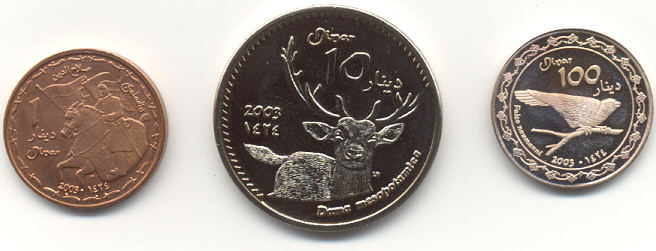
|
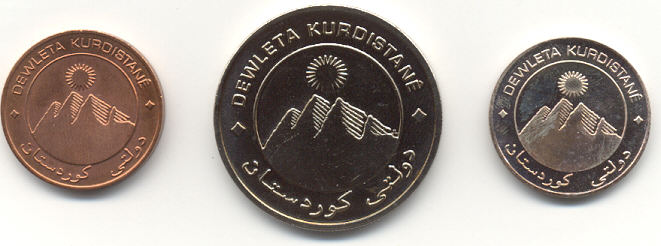
|
|
|
|
The
1 Dinar is struck in bronze-plated zinc, a material similar to that
used in the current U.S. cent, has an authorized mintage of only 5,000
pieces. The 10 Dinars coin pictures the native Persian Fallow Deer and
has an authorized mintage of only 10,000 pieces. The coin is struck on
nickel plated bronze. The silver proof 100 Dinar shows the Lesser Kestrel, a
small bird of prey from the Falcon family that is native to Kurdistan. It
has an authorized mintage of only 800 pieces. The gold proof 1000 Dinar
features Saladin riding a horse carrying a Kurdish flag. It is struck
in 22 Karat gold and contains just slightly under a half ounce (.4990 AGW)
of pure gold. Only 98 pieces were struck of this attractive gold coin. The
10 Dinar is 39mm (silver dollar size) while the other denominations are 27mm
in diameter. Mountains have figured prominently in Kurdish lore, so the
reverse of all the coins features four mountain peaks, which also represents
the four nations with major Kurdish populations. Above the mountains is a
21-rayed rising sun, which is a traditional Kurdish symbol predating the
nations conversion to Islam. The legends are in the two main dialects of
Kurdish: Sorani and Kurmanji. A significant portion of the authorized
mintages of the 1 and 10 Dinars are actually being distributed in Iraqi held
portions of Kurdistan. The 100 and 1000 Dinars are Proof-only issues, so are
not expected to circulate. These are beautiful and intriguing coins coin
from a new nation that has yet to be born.
|
|
|
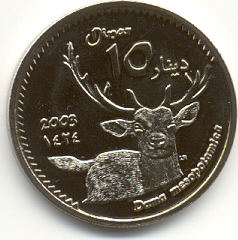 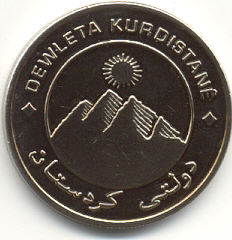 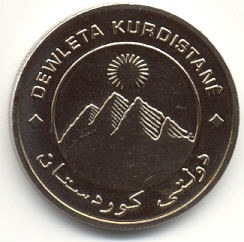 |
|
Error
Version Correct
Version |
|
In 2003, there were 4 coins
available, as mentioned above; there are also error versions of the
1 and 10 Dinars pieces. The production of these non-legal-tender pieces was
coordinated by venerable coin-dealer Joseph E. Lang (jlang@neteze.com),
from whom the coins are available. According to an article in the May 10,
2004 edition of “Coin World”, he also designed their obverse and helped
to pay for their manufacture. A handful of Kurdish groups either authorized
or were involved in this project. The American Society of Kurds even took a
few hundred coins to Iraqi Kurdistan for possible circulation.
These coins were produced by
Hoffman Mint. |
|
|
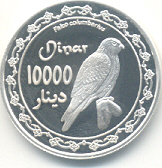 |
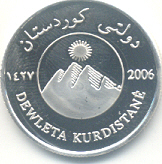 |
|
|
|
Though Kurdistan has not
achieved independence, it has not stopped issuing coins. It recently
released new gold and silver coins dated 2006. The gold 100,000 Dinar
pictures Saladin, the most famous Kurd Saladin, foe of Richard the Lionheart
and the Crusaders, was famous for his chivalry and justice. The is struck in
22 karat gold and contains a quarter ounce of pure gold. It has an
authorized mintage of only 150 pieces! The silver 10,000 Dinar shows a
Merlin (Falco columbarius). It contains 1/4 ounce of .999 fine silver and
has an authorized mintage of only 1200 pieces. Both coins feature the
Kurdistan arms on the reverse. |
|
|
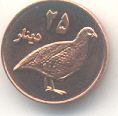 |
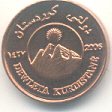 |
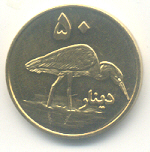 |
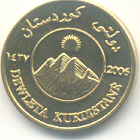 |
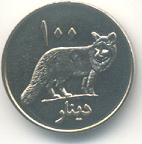 |
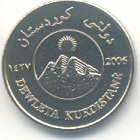 |
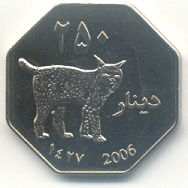 |
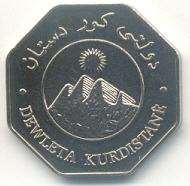 |
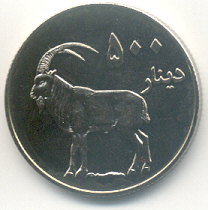 |
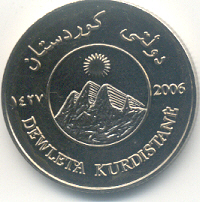 |
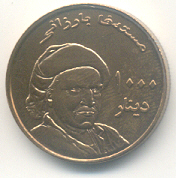 |
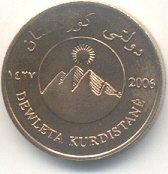 |
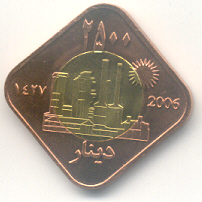 |
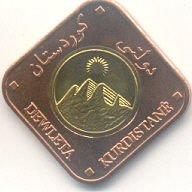 |
|
|
|
This
latest set of seven base metal coins is quite attractive. The five
lower denominations feature native wildlife. The copper 25 Dinar shows
a Grey Partridge. The brass 50 Dinars pictures a European Grey
Heron, The copper-nickel 100 Dinar shows a Red Fox. The
eight-sided copper-nickel 250 Dinars shows a Eurasian Lynx. The
copper-nickel 500 Dinar shows a wild goat. The 1000 Dinar shows
Mustafa Barzani, a charismatic Kurdish nationalist leader who died in
1979. The 2500 Dinar is an attractive and unusual square
bi-metallic coin with a copper outer ring and a brass inner
plug. It features an oil refinery in Kirkuk. All coins are dated
2006 and feature the Kurdish arms featuring the sun over the mountains
on the reverse. |
|
|
|
I purchased all
my Kurdistan coins from Joel
Anderson. I also would like thank Joel Anderson and Erik V. McCrea for their above
research and information on these
coins. |
| |
|
Micro-Nations |
| |
|
Chiefa Coins |
|
|























